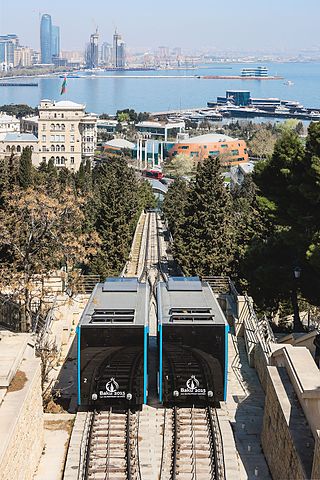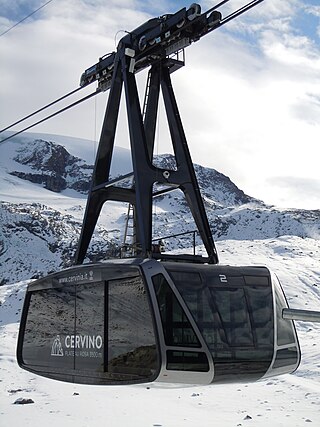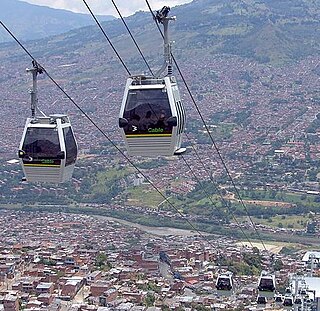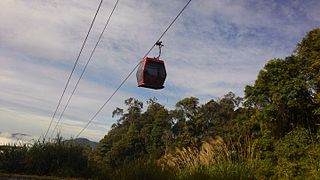Cable car most commonly refers to the following cable transportation systems:
Cable car may also refer to:
Songs

A cable car is a type of cable railway used for mass transit in which rail cars are hauled by a continuously moving cable running at a constant speed. Individual cars stop and start by releasing and gripping this cable as required. Cable cars are distinct from funiculars, where the cars are permanently attached to the cable.

A funicular is a type of cable railway system that connects points along a railway track laid on a steep slope. The system is characterized by two counterbalanced carriages permanently attached to opposite ends of a haulage cable, which is looped over a pulley at the upper end of the track. The result of such a configuration is that the two carriages move synchronously: as one ascends, the other descends at an equal speed. This feature distinguishes funiculars from inclined elevators, which have a single car that is hauled uphill.

Cable transport is a broad class of transport modes that have cables. They transport passengers and goods, often in vehicles called cable cars. The cable may be driven or passive, and items may be moved by pulling, sliding, sailing, or by drives within the object being moved on cableways. The use of pulleys and balancing of loads moving up and down are common elements of cable transport. They are often used in mountainous areas where cable haulage can overcome large differences in elevation.

An aerial tramway, aerial tram, sky tram, aerial cablecar, aerial cableway, telepherique, or seilbahn is a type of aerial lift which uses one or two stationary ropes for support while a third moving rope provides propulsion. With this form of lift, the grip of an aerial tramway cabin is fixed onto the propulsion rope and cannot be decoupled from it during operations. In comparison to gondola lifts, aerial tramways generally provide lower line capacities and longer wait times.

A gondola lift is a means of cable transport and type of aerial lift which is supported and propelled by cables from above. It consists of a loop of steel wire rope that is strung between two stations, sometimes over intermediate supporting towers. The cable is driven by a bullwheel in a terminal, which is typically connected to an engine or electric motor. It is often considered a continuous system since it features a haul rope which continuously moves and circulates around two terminal stations. In contrast, an aerial tramway operates solely with fixed grips and simply shuttles back and forth between two end terminals.

An aerial lift, also known as a cable car or ropeway, is a means of cable transport in which cabins, cars, gondolas, or open chairs are hauled above the ground by means of one or more cables. Aerial lift systems are frequently employed in a mountainous territory where roads are relatively difficult to build and use, and have seen extensive use in mining. Aerial lift systems are relatively easy to move and have been used to cross rivers and ravines. In more recent times, the cost-effectiveness and flexibility of aerial lifts have seen an increase of gondola lift being integrated into urban public transport systems.
Ropeway may refer to:

The Seilbahn Zugspitze is an aerial tramway running from the Eibsee Lake to the top of Zugspitze in Bavaria, Germany. It currently holds the world record for the longest freespan in a cable car at 3,213 metres (10,541 ft) as well as the tallest lattice steel aerial tramway support tower in the world at 127 metres (417 ft). Construction of the system began in 2015 and it opened on 22 December 2017.

An aerial lift pylon is a pylon construction bearing the cables of an aerial lift such as an aerial tramway or gondola lift. Large pylons of aerial tramways usually consist of a steel framework construction, smaller pylons of gondola lifts are made of tubular steel. Early aerial tramways often had pylons of reinforced concrete and ropeway conveyors had timber pylons, if they were cheaper than steel pylons.
Poma, incorporated as Pomagalski S.A., and sometimes referred to as the Poma Group, is a French company which manufactures cable-driven lift systems, including fixed and detachable chairlifts, gondola lifts, funiculars, aerial tramways, people movers, and surface lifts. Poma has installed about 7800 devices for 750 customers worldwide.
The following outline is provided as an overview of and topical guide to transport:

A cable grip is a device for propelling a vehicle by attaching to a wire rope running at a (relatively) constant speed. The vehicle may be suspended from the cable, as in the case of aerial lifts such as a gondola lift (télécabine), may be guided by rails, as in a cable traction railway, or may be self-guiding, as in a button lift. Typically, multiple vehicles will use the same cable; where just one or two vehicles are in use they will tend to be attached to the cable permanently such as in funiculars.

Metrocable is a gondola lift system implemented by the City Council of Medellín, Colombia, with the purpose of providing a transportation service that complements the Medellín Metro. It was designed to reach some of the city's informal settlements on the steep hills that mark its topography. It is largely considered to be the first urban cable propelled transit system in South America. The transportation infrastructure is already established and has been in service since 2004.

The Port Vell Aerial Tramway is an aerial tramway in Barcelona, Catalonia, Spain. It crosses Port Vell, Barcelona's old harbour, connecting the Montjuïc hill with the seaside suburb of Barceloneta.

The Metrocable de Caracas is a gondola lift system integrated with the city's public transport network, which provides quick and safe transportation for those who live in the neighbourhoods situated on Caracas's mountainous regions. The system was built as a tool for social reform with stations set up to accommodate a variety of services such as daycares, libraries, police stations, markets and theatres.

The Genting Highlands Premium Outlets Cable Car, is a gondola lift system connecting Awana Transport Hub, Chin Swee Temple and SkyAvenue in Genting Highlands, Pahang, Malaysia since December 2016. The Awana Transport Hub terminus consists of the new Genting Highlands Premium Outlets Terminal, the station building and a new 8-storey car park while the other terminus is located at SkyAvenue.
The following outline is provided as an overview of and topical guide to public transport: